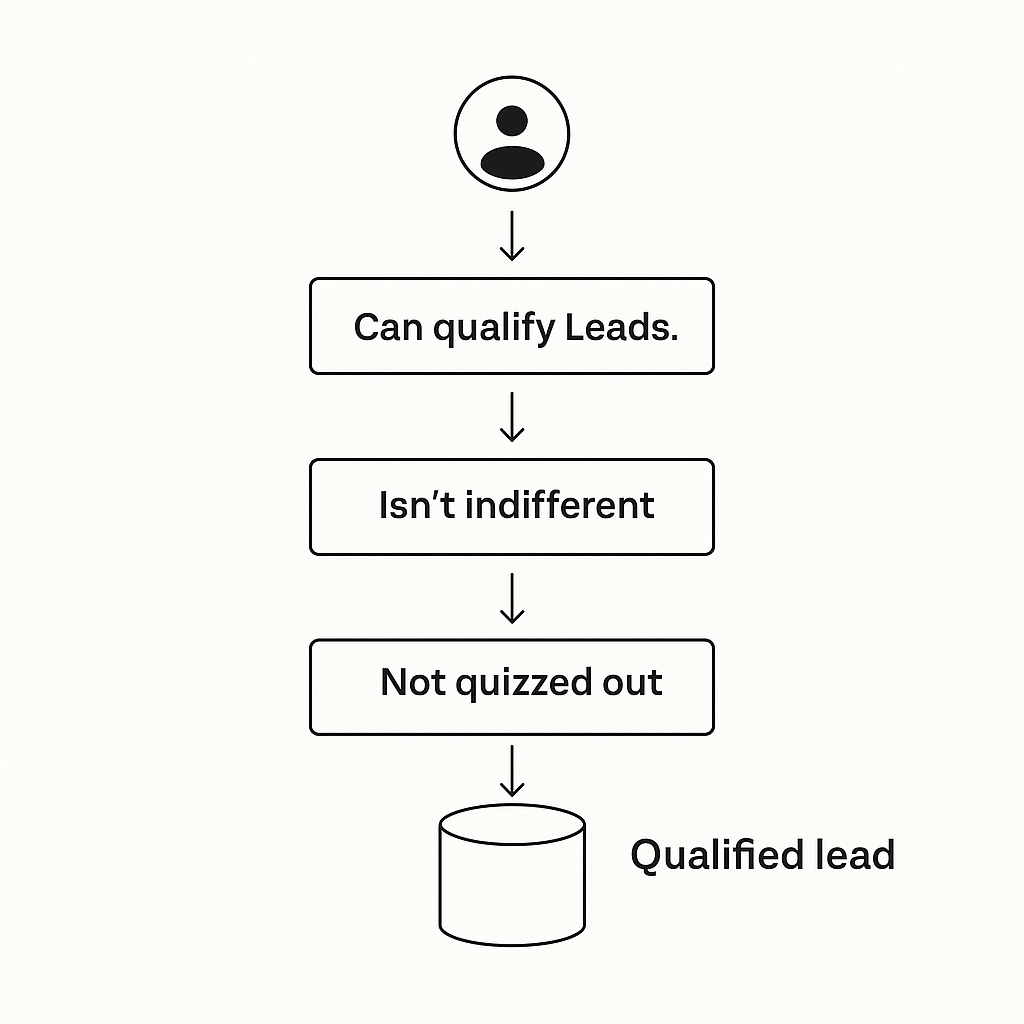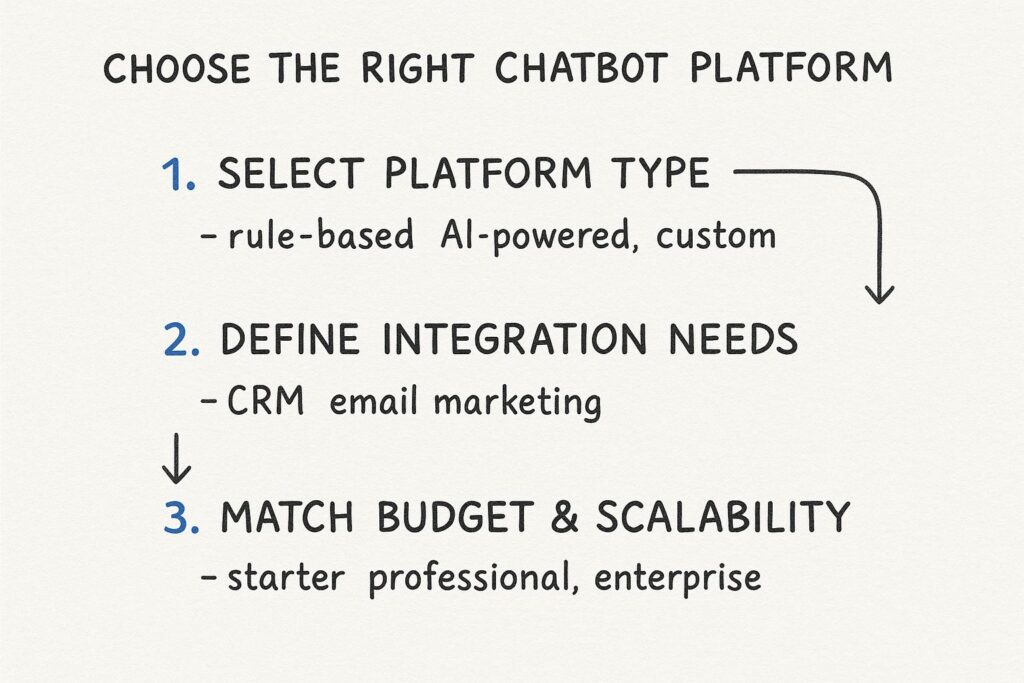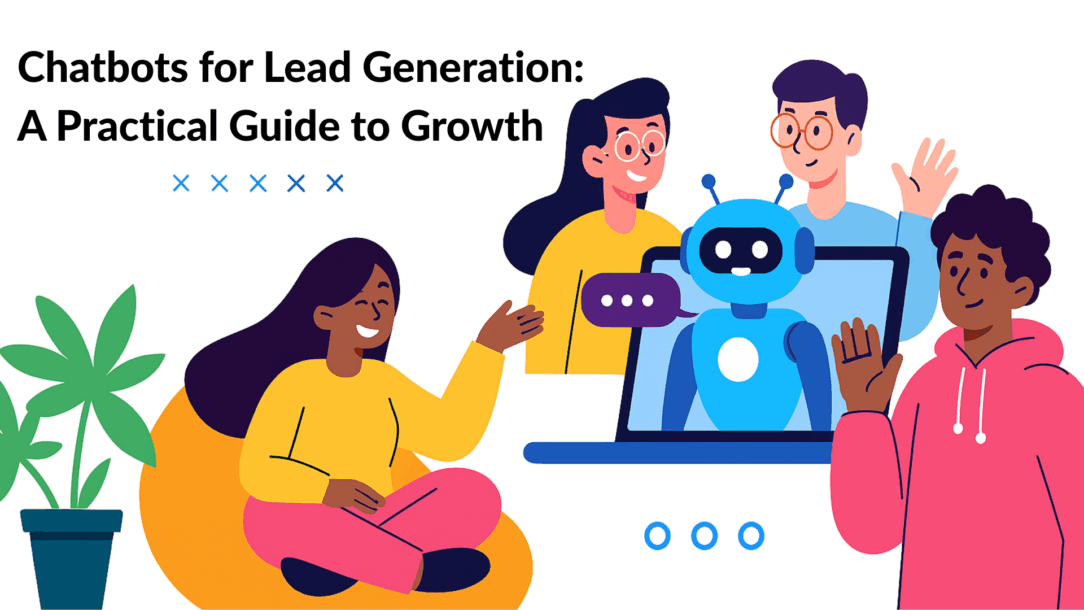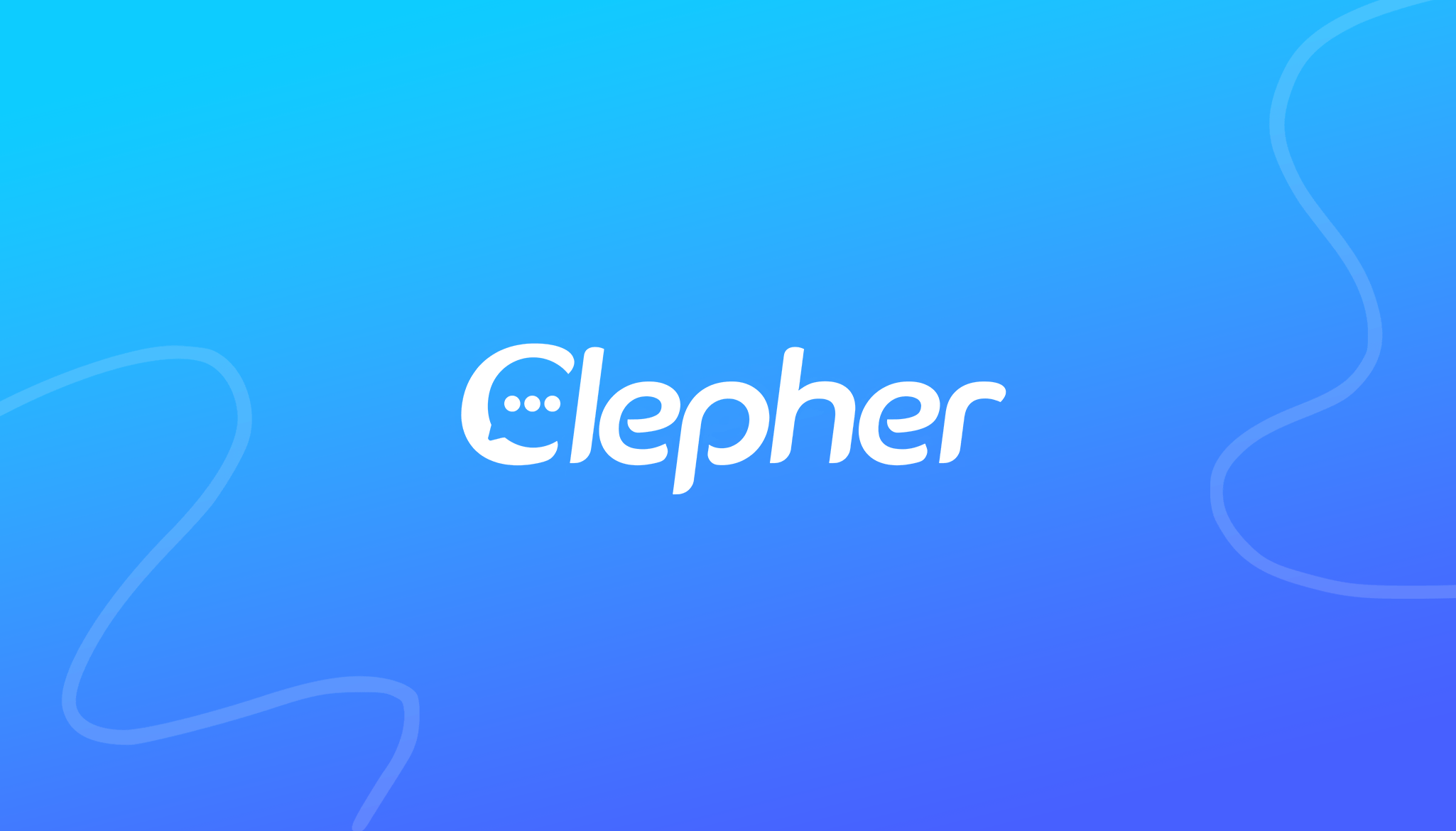Chatbots for lead generation are automated tools that have real-time conversations with your website visitors. Instead of forcing people to fill out a static form, these AI assistants proactively start dialogues, answer questions 24/7, and guide prospects through your sales funnel. The result? A significant boost in engagement and more qualified leads for your sales team.
Why Chatbots Are Your New Lead Generation Superpower
Imagine your website is a physical store. Right now, most visitors just walk in, browse, and leave without ever speaking to anyone. A classic “contact us” form is like a suggestion box nailed to the door—most people walk right past it.
Now, picture a friendly, smart assistant greeting every person who walks in, ready to answer questions and offer help. That’s exactly what a chatbot for lead generation does for your website.
These tools transform your site from a passive brochure into an active sales assistant that works around the clock. They engage visitors the moment they show interest, turning a one-way street into a two-way conversation. It’s the difference between leaving a voicemail (filling a form) and having a real conversation that leads somewhere.
From Leaky Funnel to Proactive Machine
The traditional sales funnel is full of holes. Potential leads get bored waiting for an email response or abandon a long, clunky form. A chatbot plugs those leaks by giving people instant answers. This immediate gratification is crucial for converting modern buyers who expect help now.
One of the biggest wins is the direct impact on conversion rates. When exploring strategies to increase website conversions, chatbots stand out as a modern essential. Websites using AI chatbots can see their conversion rates jump by an average of 23%.
Why such a big lift? Because chatbots remove friction. They make it incredibly easy for a visitor to take the next step, like booking a demo or asking a pricing question. Leads generated through a chatbot often convert three times faster than those from a standard email form, proving the power of immediate, real-time conversation.
They don’t wait for you to find a form; the chatbot starts the conversation with a simple, direct question.

chatbot to start conversations
This simple pop-up replaces a static form with an interactive question. Just like that, the user is pulled into a helpful conversation, not a demanding one.
Traditional Lead Forms vs. Chatbot Conversations
The difference in user experience between a form and a chatbot is night and day, which directly impacts your results.
| Feature | Traditional Lead Form | Chatbot for Lead Generation |
|---|---|---|
| User Interaction | Passive, one-way data entry | Interactive, two-way conversation |
| Response Time | Delayed (hours or days) | Instant, 24/7 |
| Engagement | Low; often seen as a chore | High; feels like a helpful chat |
| Lead Qualification | None; all data is collected equally | Real-time, asks targeted questions |
| User Experience | Impersonal and static | Personalized and dynamic |
| Friction | High; requires effort and patience | Low, guides the user step-by-step |
| Conversion Rates | Typically lower | Significantly higher |
A form is just a gatekeeper for data. A chatbot is a guide that actively helps people, making the entire process feel more human and efficient.
The Core Functions of a Lead Generation Chatbot
At its heart, a chatbot isn’t just a fancy pop-up—it’s an automated engine built to handle crucial business tasks. By starting conversations, it achieves several key goals at once.
- Immediate Engagement: It proactively greets visitors on high-intent pages like pricing or product tours, preventing them from bouncing before you connect.
- Lead Qualification: The chatbot asks smart, targeted questions to see if a visitor fits your ideal customer profile—think company size, role, or specific challenges.
- Data Collection: It gathers key contact info like names and emails as part of a natural conversation, which feels far less intrusive than a form.
- Automated Scheduling: For qualified leads, the bot can sync with your sales team’s calendars and book a demo on the spot. No more email back-and-forth.
By automating these top-of-funnel tasks, your chatbot frees up your sales team to focus on what they do best: closing deals with high-value, pre-qualified prospects.
How Chatbots Qualify Leads in Real Time
The old way of getting leads is like fishing with a giant net. You haul in everything—the big fish, the small ones, and a lot of seaweed. Your sales team then wastes hours sorting through it all to find the keepers.
A chatbot is different. It’s like a skilled angler who uses the right bait. It attracts and qualifies the right kind of fish before they even get in the boat.
This is where chatbots truly shine. They act as a smart filter, ensuring your sales team only talks to prospects who are a genuine fit. Instead of a generic contact form, the bot initiates a dynamic, one-on-one conversation to determine quality.

qualifying leads
Asking the Right Questions at the Right Time
A chatbot’s power comes from asking smart, strategic questions designed to gather info that matches your Ideal Customer Profile (ICP). The key is to be helpful, not invasive. The bot frames its questions as a way to better assist the visitor.
Use Case: B2B Software Company A bot on a pricing page might ask:
- “To connect you with the right expert, could you tell me your team’s size?”
- “What’s the biggest challenge you’re hoping a new tool will solve?”
- “Are you the main decision-maker for software purchases?”
Use Case: E-commerce Store A bot helping a shopper could ask:
- “Just so I can narrow things down, are you shopping for yourself or for a gift?”
- “What’s your budget for this? We have fantastic options in every price range.”
Each answer provides a piece of data the bot uses to score the lead instantly.
The Mechanics of Real-Time Lead Scoring
As the conversation progresses, the chatbot assigns a value to each response behind the scenes. A prospect from a company with 100+ employees might get +10 points, while someone from a startup gets +2. A decision-maker scores higher than an intern.
This automated scoring is an engine of efficiency. It instantly separates high-intent leads from casual browsers, allowing your sales team to prioritize their time with laser focus.
This process eliminates costly delays. According to one study, a five-minute delay in responding to a lead can slash your odds of qualifying them by 80%. Chatbots erase that delay entirely.
To dive deeper into the mechanics, our guide on how to qualify leads with chatbots breaks it down further.
From Qualification to Handoff
Once a lead hits a certain score, the chatbot smoothly executes the next step, creating a frictionless journey from initial chat to a real sales conversation.
Here’s how the handoff works in practice:
- High-Value Lead Identified: The bot flags the user as sales-ready based on their answers.
- Instant Human Handoff: The bot can ping an available sales rep for a live chat takeover. The rep gets the full conversation transcript for context.
- Automated Meeting Scheduling: If no reps are free, the chatbot connects to their calendars, offers available time slots, and books a demo right there in the chat window.
This entire sequence can happen in less than a minute. The result is a shorter sales cycle and a prospect who is impressed by the fast, professional experience.
Key Chatbot Strategies for Maximum Lead Capture
Simply dropping a generic chatbot onto your website isn’t enough. The real magic comes from being strategic about how and when that bot appears. To effectively capture leads, your chatbot needs to be a smart, dynamic assistant that understands visitor context.
Proactive vs. Reactive Engagement
First, decide if your bot should be proactive (starts the conversation) or reactive (waits for the user to click). This choice should be driven by the page’s purpose.
- Proactive Engagement: Use this for high-intent pages like pricing, product features, or demo requests. When someone is actively evaluating your solution, a bot that pops up with, “Have questions about our plans?” is incredibly powerful. You’re engaging them at their peak interest.
- Reactive Engagement: On lower-intent pages, like a blog post or an “About Us” page, a proactive bot can feel pushy. Here, a reactive approach is better. The bot sits quietly in the corner, ready to help if the visitor decides they need it.
Customize Conversations for Page Context
Context is everything for chatbots for lead generation. A bot on your pricing page needs a different script than one on a blog post. This page-specific customization shows visitors you’re paying attention to their needs.
Actionable Tip: On a blog post about solving an industry problem, program your bot to say, “Enjoying the article? I can send you a free checklist that solves this exact problem. Just let me know your email.” This feels helpful, not salesy.
It doesn’t ask a vague question. It offers specific pathways directly related to the product page, guiding users toward logical next steps.
Your goal is to make every chatbot interaction feel like a natural extension of the user’s journey. Match the conversation to the page content to transform a simple tool into a powerful conversion machine.
The Critical Role of CRM Integration
A chatbot working in a silo is a huge missed opportunity. The most crucial strategy is connecting your chatbot directly to your CRM platform, like HubSpot or Salesforce. This is what turns conversations into a scalable lead generation system.
When a lead is qualified, a proper integration does more than just send an email notification:
- Creates a New Contact: The lead’s info (name, email, company) is instantly added to your CRM, eliminating manual data entry.
- Logs Conversation History: The full chat transcript is attached to the contact record, giving your sales team all the context they need for a meaningful follow-up.
- Triggers Automation: The CRM can automatically trigger email nurture sequences, assign the lead to the right sales rep, and update their pipeline status.
This seamless handoff ensures no lead falls through the cracks and creates a smooth transition from an automated bot to a human, which is essential for closing deals.
Real-World Examples of Lead Generation Chatbots
Theory is great, but seeing how businesses use chatbots to turn casual visitors into qualified leads is where the value becomes clear. A well-designed chatbot isn’t just a support tool; it’s a sales and marketing engine that drives measurable growth.
Use Case 1: B2B Tech Booking Qualified Demos
For B2B SaaS companies, the primary goal is booking more sales demos with the right people. A chatbot acts as the perfect gatekeeper.
The Scenario: A visitor lands on a pricing page. After a few seconds, a chatbot appears: “Hey there! Looking into our plans? I can help you find the perfect fit. What’s your team’s size?” This kicks off the qualification process.
The bot continues with targeted questions:
- Pain Point: “What’s the biggest challenge you’re hoping to solve?”
- Role: “To connect you with the right expert, what is your role at the company?”
If the answers match the company’s ideal customer profile, the bot makes its move: “It sounds like our Enterprise plan would be a great fit. A specialist can walk you through a personalized demo. Do you have 15 minutes to connect this week?” It then integrates with a sales rep’s calendar and books the meeting directly in the chat window.
The Result: This flow transforms a passive visitor into a scheduled, qualified sales meeting in under two minutes. Companies using this strategy report increasing their demo bookings by as much as 40%.
Use Case 2: E-commerce Recovering Abandoned Carts
E-commerce stores lose significant revenue to cart abandonment. A chatbot can act as a proactive shopping assistant to nudge customers over the finish line. E-commerce is a perfect fit for chatbots; online shoppers have the highest acceptance rate for bot interactions at 34%.
The Scenario: A shopper adds items to their cart but hesitates on the checkout page. The chatbot detects this “exit intent” and chimes in: “Hey, it looks like you found some great items! Before you go, did you have any questions about shipping or returns?”
If the user engages, the bot can sweeten the deal:
- The Offer: “I can offer you free shipping on this order if you complete your purchase in the next 10 minutes. Would you like me to apply the code for you?”
This simple, automated nudge feels helpful, tackling common friction points and creating urgency.
The Result: By using chatbots to offer personalized discounts or answer last-minute questions, e-commerce brands have recovered an average of 15% of otherwise lost sales.
Use Case 3: Real Estate Qualifying Buyers
Real estate agents waste countless hours on inquiries from people who aren’t serious or financially ready. A chatbot on an agency’s website can automate this initial qualification 24/7.
The Scenario: A visitor lands on a property listing. The bot starts the conversation: “Hi! Interested in this beautiful home? I can help you schedule a viewing. First, are you already pre-approved for a mortgage?”
The bot then gathers other crucial details:
- Timeline: “What is your ideal timeframe for moving?”
- Budget: “What is your approximate budget for a new home?”
For qualified leads, the bot syncs with an agent’s calendar to book a viewing. For those who aren’t ready, it offers helpful resources like a mortgage calculator, capturing their email for future nurturing.
The Result: This automated filter gives agents dozens of hours back each week. Agencies using this tactic report a 30% increase in scheduled viewings with serious, purchase-ready buyers.
Choosing the Right Chatbot Platform for Your Business
With so many options, picking the right chatbot tool can be overwhelming. The key is to match the platform’s capabilities to your specific business needs, technical resources, and budget. It’s important to understand the difference between simple tools and robust business-grade chatbot platforms built for complex conversations.
The global chatbot market has exploded, valued at roughly $15.57 billion today. This rapid growth shows how essential chatbots for lead generation have become for businesses wanting to scale personalized conversations.
Understanding the Three Main Types of Chatbots
Let’s break the options down into three main categories. Each serves a different purpose and comes with its own trade-offs.
- Rule-Based Chatbot Builders: These are the most straightforward platforms, perfect for getting started. They operate on a simple “if-this-then-that” logic, following a pre-designed conversation script. They’re great for basic lead capture, FAQs, and guiding users through a simple process.
- AI-Powered Platforms: These chatbots use Natural Language Processing (NLP) to understand what a user is asking. Instead of being locked into a rigid script, they can handle variations in language and carry on more natural, human-like conversations. They are ideal for businesses that need to qualify leads with more nuance.
- Fully Custom Solutions: Built from the ground up by developers, these are enterprise-grade solutions designed for maximum control and deep integrations. They are the most powerful and expensive option, tailored to a company’s specific operational needs.
Comparing Chatbot Platform Types
| Platform Type | Best For | Key Features | Typical Cost |
|---|---|---|---|
| Rule-Based Builders | Small businesses, simple lead capture, FAQs, and appointment booking. | Visual drag-and-drop editor, pre-built templates, easy setup. | $-$ |
| AI-Powered Platforms | Growing businesses, complex lead qualification, and personalized support. | NLP, machine learning, CRM integrations, and advanced analytics. | $-$$ |
| Fully Custom Solutions | Large enterprises with unique security, data, and integration needs. | Total customization, proprietary data models, advanced security. | $$$+ |
The goal isn’t just to pick a platform, but to pick the right solution for your business stage. A simple rule-based bot might be all you need today.
A Checklist for Making Your Decision
Before committing to a platform, run through this quick checklist. The answers will help you confidently pick a tool that will deliver a return on your investment. For a deeper dive, our guide on the best chatbot for lead generation compares some of the top players on the market.
Key Takeaway: The best platform isn’t the one with the most features—it’s the one that most effectively solves your specific business problem, whether that’s booking more demos or qualifying buyers.
- Ease of Use: Does it offer a no-code, drag-and-drop builder, or will you need a developer?
- Integration Capabilities: Can it connect seamlessly with your CRM (like Salesforce or HubSpot) and other marketing tools?
- Scalability: Will this platform grow with you as your traffic and needs increase?
- Pricing Model: Is it based on contacts, conversations, or a flat monthly fee? Ensure the model fits your budget now and in the future.
Your Step-by-Step Implementation Plan
Let’s turn strategy into action. This practical plan will help you build and launch your first lead generation chatbot with confidence.
Step 1: Define Your Primary Goal
Before you write a single message, define what success looks like. A chatbot without a clear, measurable goal is just a website decoration.
What is your number one objective?
- Book more qualified sales demos?
- Increase newsletter sign-ups?
- Register attendees for a webinar?
Pick one primary goal to start. For example: “Increase qualified demo bookings by 20% in the next quarter.” This focus makes every other decision easier.
Step 2: Identify Your Audience and Qualifying Questions
Next, who are you talking to? Based on your goal, sketch out your ideal lead. What key information do you need to know to qualify them?
Come up with three to five essential qualifying questions. If your goal is demo bookings, you might ask about company size, the person’s role, and their biggest challenge. These questions are the core of your chatbot’s logic.
A great chatbot conversation feels like a helpful consultation, not an interrogation. Frame your questions to guide the user toward a solution while gathering the data you need.
Step 3: Script Your Conversational Playbook
With your goal and questions set, map out the conversation flow. Start with a warm greeting, then guide the user through your qualifying questions.
For qualified leads, create a clear path to the next step, like presenting a calendar to book a meeting. For those who aren’t a good fit, offer something else of value, like a link to a relevant case study or an ebook download. If you need inspiration, exploring the top 10 chatbot templates for automated conversations can provide proven structures.

choosing the right chatbot platform
As you build, find the sweet spot between the platform type, its integrations, and your budget.
Step 4: Launch, Test, and Optimize
It’s time to go live. Deploy your chatbot, but start small. Place it on one high-traffic page, like your homepage or pricing page. This controlled launch allows you to gather real-world data without disrupting your entire site.
Monitor its performance closely. Read conversation transcripts to see where people get stuck or drop off. Use that data to tweak your script and improve the experience. This cycle of testing and optimizing is what turns a good chatbot into a lead generation machine.
Still Have Questions? Let’s Clear a Few Things Up
It’s smart to ask questions before adopting any new strategy. Here are answers to a few common concerns about chatbots.
Will a Chatbot Replace My Sales Team?
No. Think of a chatbot as your sales team’s best assistant. Its job is to handle the repetitive, top-of-funnel work—like greeting visitors and asking initial qualifying questions—24/7.
This frees up your human reps to focus on what they do best: building relationships and closing deals with the high-quality, pre-qualified leads the bot delivers. The chatbot is the filter that makes your sales team more efficient.
How Much Does a Lead Generation Chatbot Cost?
The price varies widely based on complexity.
- Simple, rule-based platforms can start as low as $20-$50 per month.
- More advanced AI-powered platforms typically run from a few hundred to several thousand dollars a month.
- A fully custom-built enterprise solution is a major project and could cost anywhere from $10,000 to over $100,000 to develop.
How Do I Measure the ROI of My Chatbot?
Measuring your return is about tracking metrics that directly impact your bottom line. When you see how many qualified opportunities the bot generates, you can tie its performance directly to revenue and cost savings.
To calculate your chatbot’s ROI, focus on these core metrics: Number of Leads Captured, Lead-to-Meeting Conversion Rate, Lead Qualification Rate, and Cost Per Lead (compared to your other channels).
Can I Use Chatbots on Social Media for Lead Generation?
Absolutely. This is one of their superpowers. Many chatbot platforms integrate directly with channels like Facebook Messenger and Instagram DMs.
You can set up a bot to instantly respond to messages, run automated quizzes, deliver lead magnets, and qualify prospects right inside the chat. It’s an effective strategy because you’re capturing leads where your audience already spends their time.
Conclusion
In summary, implementing chatbots for lead generation can significantly enhance your business goals by transforming site visitors into high-quality leads. By utilizing an AI chatbot, you can streamline your lead management process, enabling your sales team to qualify leads faster and nurture them effectively. These chatbots are designed to identify potential customers through conversational marketing, providing real-time engagement and quick answers to user responses.
Moreover, the integration of natural language processing (NLP) allows for a seamless user experience, ensuring that your chatbot delivers relevant information within the chat interface. By embedding a lead generation chatbot on your website, you can collect contact information and enrich your lead data, ultimately improving your conversion rate.
For marketers looking to generate more leads, a complete guide to lead generation involving chatbots is essential. With tools like Clepher, you can build an AI-driven chatbot that captures leads efficiently while keeping them engaged. This not only aids in the qualification process but also complements your existing marketing campaigns.
As you embark on your journey to build a lead generation chatbot, remember that the right choice of tools and strategies will empower you to convert visitors into leads and achieve your desired business outcomes.
Related Posts



